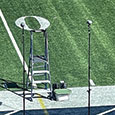The first competitions of the season are being held and many teachers have had their first judging experience of the year. I often wish I could have fifteen minutes with the flutists before they play because there are numerous issues which could be fixed immediately, and others that would help a future event. Most of these ideas apply to recital performances as well.
Check the Cork
A day or so before the competition students should check the cork to be sure that it has not moved. At this time of year when the weather changes from day to day, the cork can shrink and move to another setting very quickly. If the cork is out of place, then when tuning to the piano A, the flute will be in tune for that note, but the relationships to the other notes will be out of sync.
Putting the Flute Together
When a student is nervous, even basic concepts can fall by the wayside. Students often rush and do not check alignment before walking on stage. Judges can see this because they are constantly fiddling with the headjoint during the performance. A few days before a competition it is wise to align the flute and mark a few lines between the headjoint and the body of the flute with a felt tipped marker. The goal is to have the headjoint properly aligned with the body to create the desired sound and intonation.
Not Warming Up Well
It is best to do a partial warmup at home or in the hotel before going to the competition venue. After arriving, they can finish the warmup. Advise them to pay particular attention to the time as they do not want to be warmed up too soon or not warmed up enough. Generally, warming up about 30 minutes before a performance time is a good rule to follow. The warmup should not be playing the competition piece over and over again. Rather it should include the types of flute techniques that will be used in the competition repertoire.
If a performance piece includes many scale-type areas, students could practice slow, moderate and fast scales in those keys. Or, if a piece requires tapering of high notes, they can practice an exercise to help reduce the size of the aperture to make a beautiful, controlled taper. If the work has fast articulated passages, suggest practice in double/triple tonguing on all the notes in a particular register to be sure the tongue is placed well and can move easily. I like to practice trills to warm and relax my fingers. An option is to play a scale and trill each note.
Clothing
Most performers do not practice in the clothing they are going to wear for the competition. This can lead to all sorts of problems especially in the area of shoes. In many opera companies, the female lead wears athletic shoes under her ball gown. Performing a lead role in an opera means many hours on stage. Standing in uncomfortable shoes for a long time takes a toll on the sound quality of the voice. To breathe well the body also should be aligned properly. Very high-heeled shoes throw off the balance and breathing is compromised. For men a necktie that is too tight or a shirt with sleeves that are uncomfortable when the arms are positioned to play the flute can be distracting and uncomfortable. All black clothing can be a bit boring. Bring a little more to the performance and dress up.
Check Out the Hall
Most performers have never played in the competition venue. If possible, it is a good idea to go into the hall at an earlier time. This allows time to get used to the size of the room and lighting. If possible, it helps to play a few notes in the hall to discover what the acoustics are like. If the hall is very live and has a lot of reverberation, then notes should be played shorter so the tone projects with clarity. On the other hand, if the hall is dry and has no ring, then players can hold notes a bit longer and perhaps add more vibrato to create an artificial ring. So many competitors walk onto the stage and are looking around in awe when they should be concentrating on what they are going to play.
Walk Out Confidently
When performing or competing, players should walk out like this is their favorite thing in the world to do. Everyone is nervous at this point, but this is part of the performance as well. Tell students to practice this element of their presentation. They should breath and move quickly and efficiently to the place where they will play, and smile and show animation as they walk on stage. This gives the impression of friendliness and invites the judges or audience to appreciate the performance. If a player demonstrates nervousness instead, the audience feels uncomfortable for them and may focus on that instead of enjoying the music.
Move the Chairs and Stands
Especially with chamber music competitions, the chairs and stands may be set up for another group or at random. The ensemble will suffer if the chairs are too far apart. Ensemble playing is best when the players are close together so they can have good visual and breathing contact. Take the time to move the chairs to group’s preferred set up. The judges will also notice that the players know what they are doing.
If this is a competition in which a sonata is part of the required repertoire, it is usually played with music. Players should decide early in their practice where they want to stand in relationship to the piano. Some flutists like to stand in the crook of the piano while others prefer to play on the right-hand side of the accompanist. This should be consistent once decided. The stand should be closer to the piano than to the audience. The height of the stand is important to because the judges and the audience want to see the player’s face too.
Before beginning to play, players should check the lighting to be sure that they can see the music. If the stand is too far forward to the front of the stage, it may not be in the optimum position for overhead lighting. Check to be sure all pages are in order. If there are copied pages because of a tricky page turn, be sure they are taped into place. If there is a sudden draft on stage music can go flying. The stand should be as low as possible. Practice at home should do this too.
Play like a Rock Star
While rock stars play in large venues, flutists mostly practice in small cell-like practice rooms. During preparation, students should practice in a variety of locations. They should learn to fill the hall with their tone and energy. Projection is not about playing loudly, but rather playing with confidence and a ringing sound.
Dealing with Mistakes
During lessons and preparation, have students practice what to do if they make a mistake. It is easy to fall into the habit of making a grimace with every error. This then is likely to happen in performance as well. Judges and audiences may not notice a mistake if no attention is called to it, and even if they do hear it, a graceful recovery allows the musical mood to continue without interruption. A good mental approach is to move on and think about playing the next passage beautifully.
Practice Endings
Help students decide what to do at the end of each movement and the finish of the work. If a movement ends in a taper, then they should be still after finishing the note. This is called holding the audience. If a performer remains still for a moment, the audience will not begin to clap too soon and break the effect of the finish. If the ending is a barn-burner, players should experiment with how to cut off the final note. The best performers do so with a smile and twinkle in their eyes, drawing the audience into the excitement of the moment. It is useful to record a video to see how the end each movement looks. This makes it much easier to see what can be done to make it smoother and more effective.
Keep Quiet After a Performance
After playing, many people are keyed up and want to talk about what went right and wrong in their own and other’s performances. This is a bad idea. It is better to save these to discuss at a future lesson and just smile and be friendly with other competitors. Most likely they will be at other events in the future. No matter what the outcome – win or lose – it is important to be gracious and compliment other performers. The attitude someone displays will be remembered long after the results of a particular competition are forgotten.
Competions can greatly add to a students’ development. With some advance planning and preparation, the experience will be more successful and joyful. I always emphasize to students, however, that competitions are just a snapshot of one particular moment in their playing. I have both won and lost when I played well and when I played poorly. What they take and learn from the performance is far more important.






